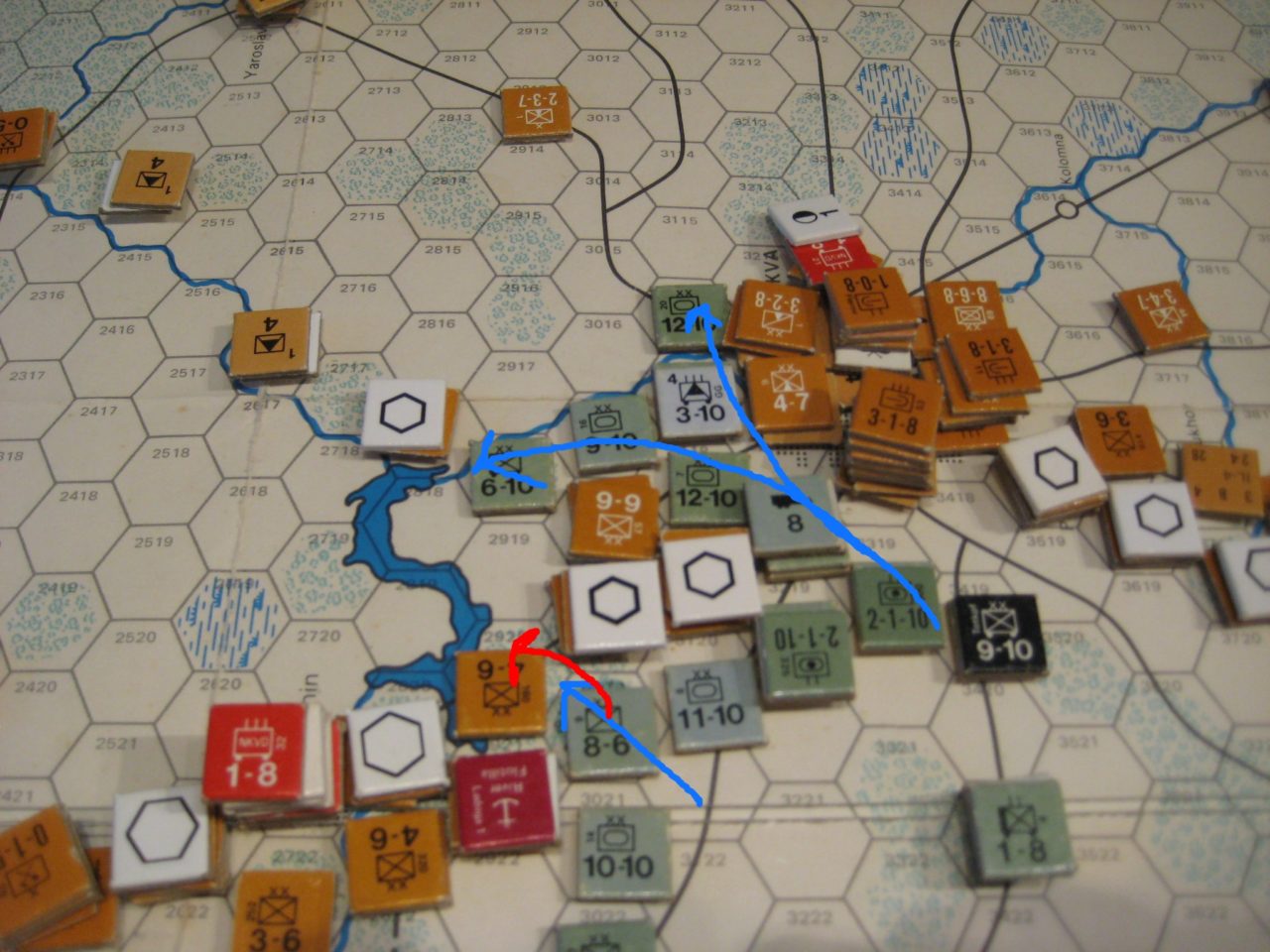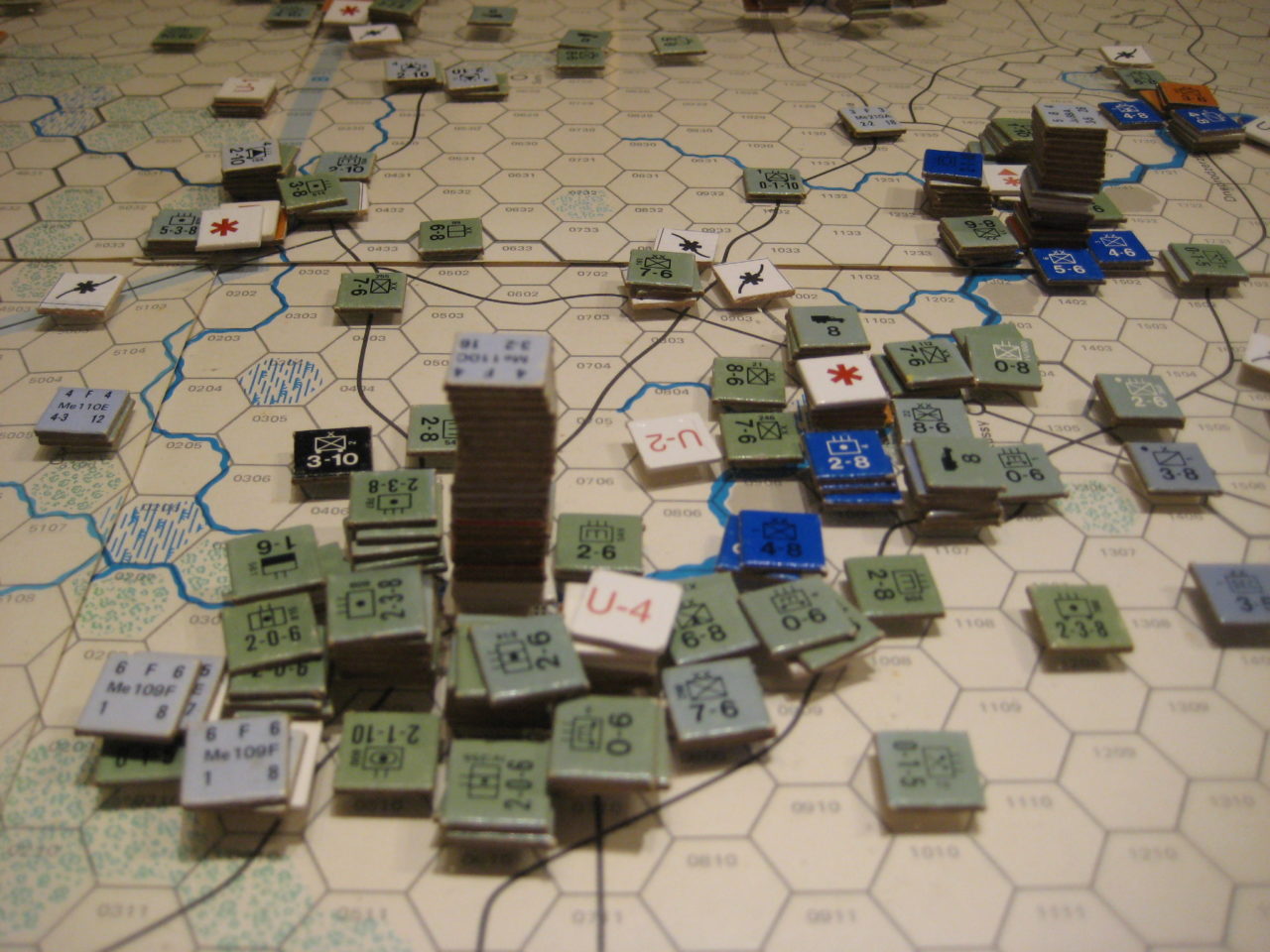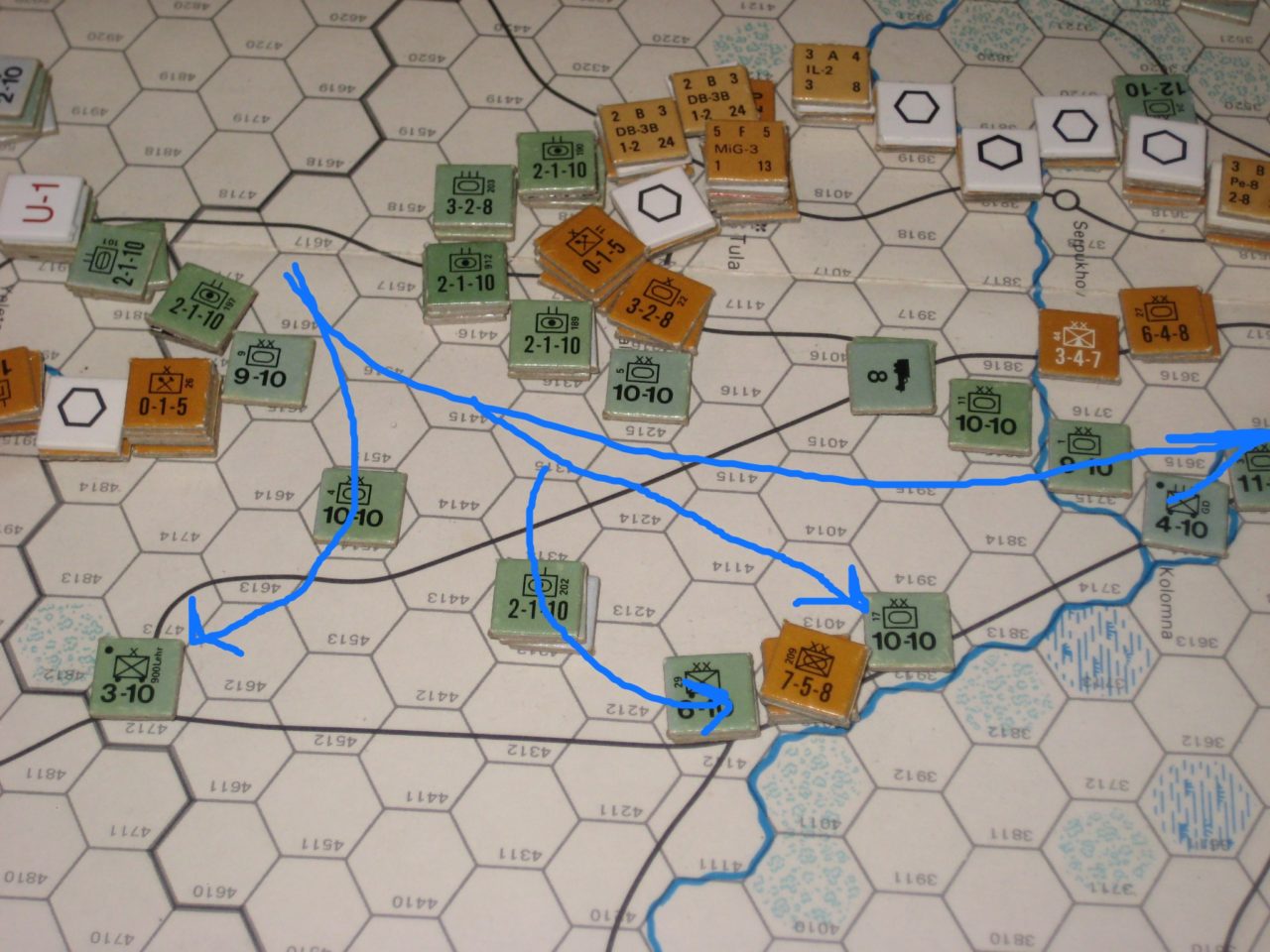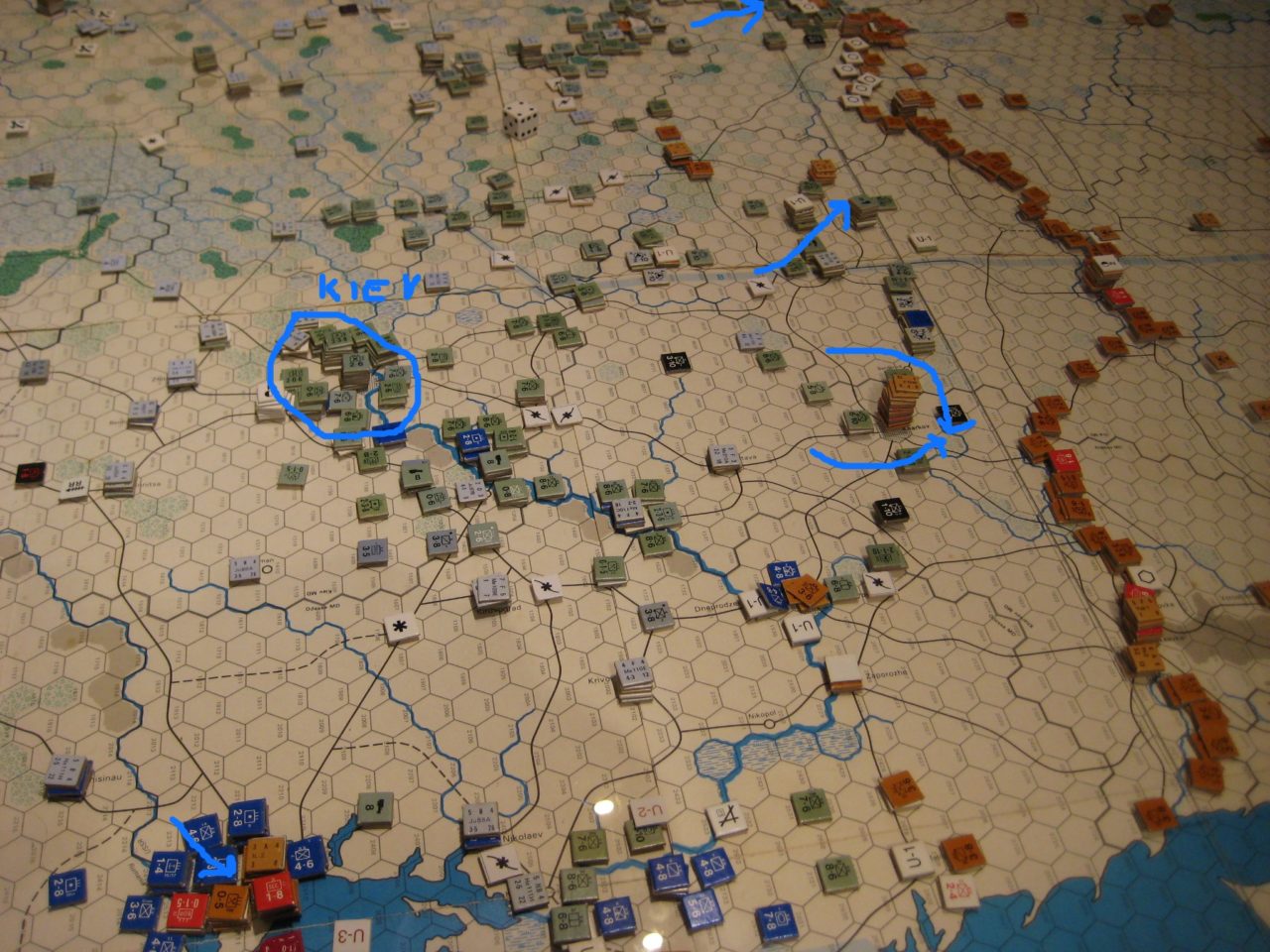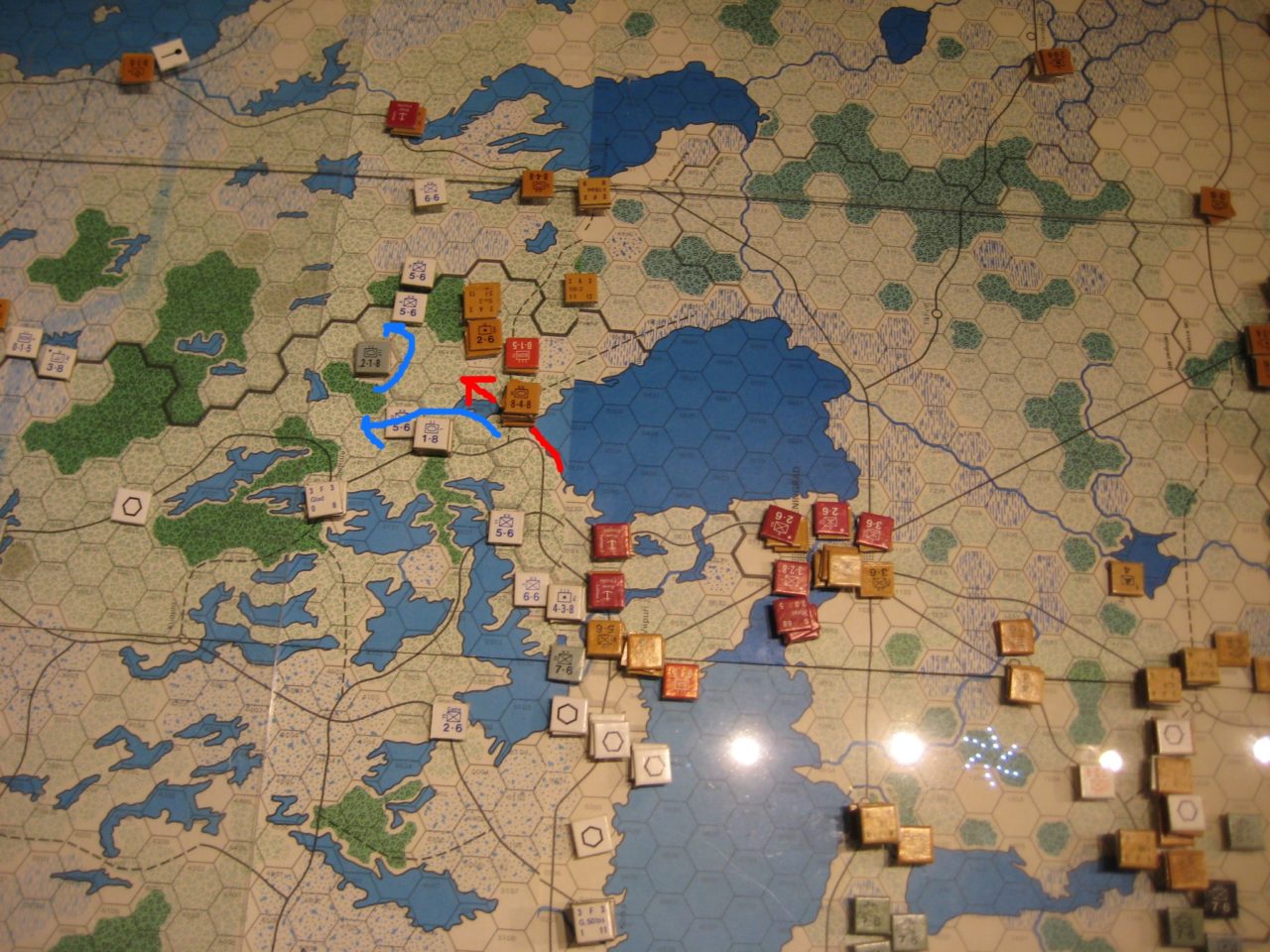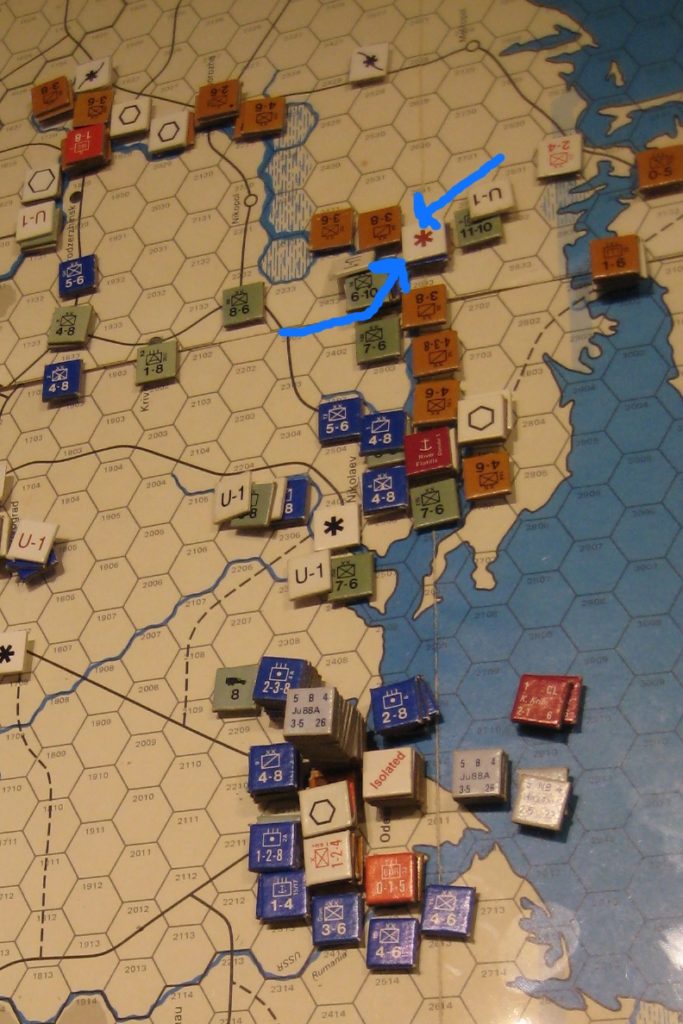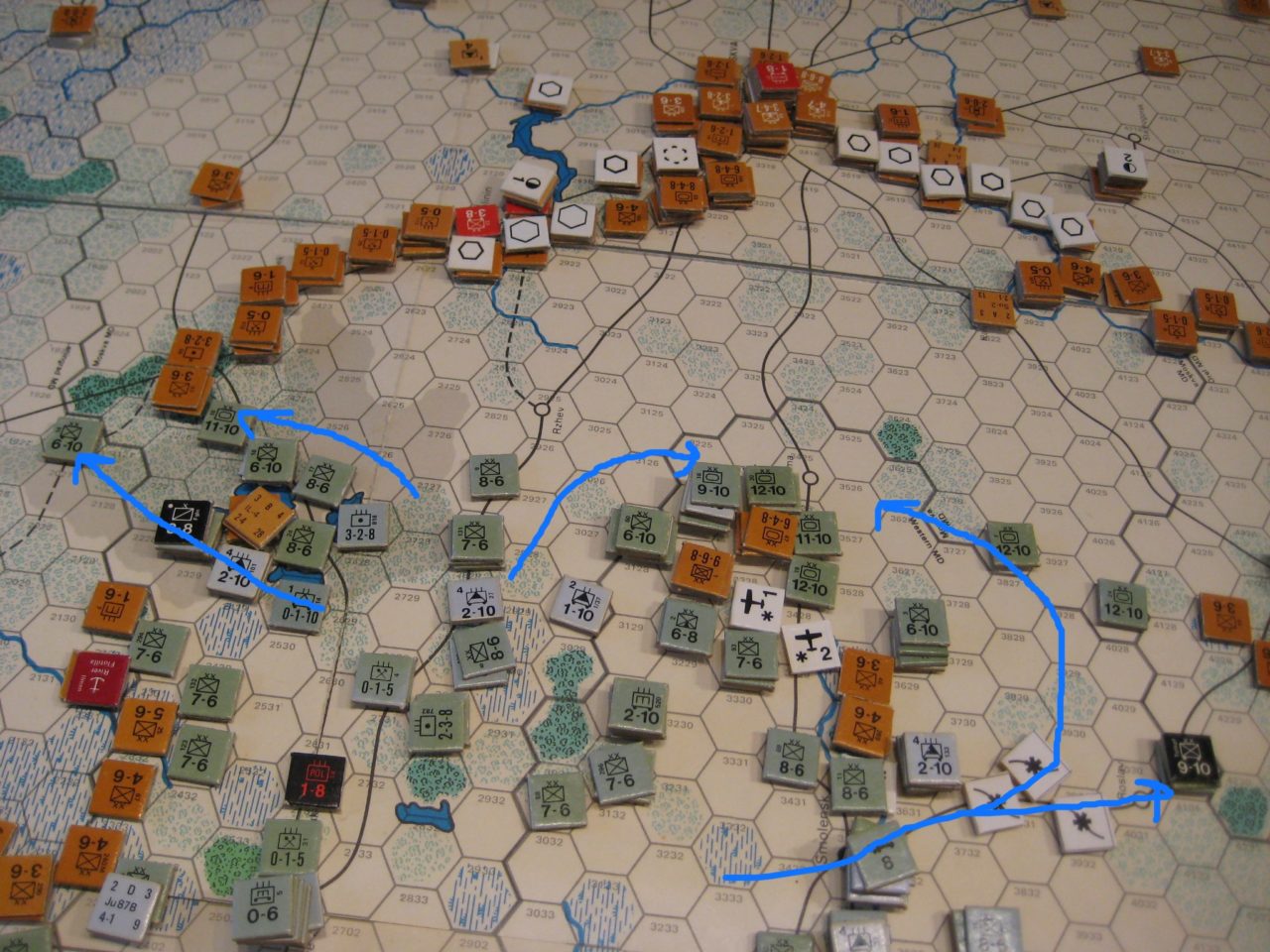Allied Jan I 42: The Allies remained in place at Matruh.
Axis Jan I 42: The Axis rebuilt both Pz divisions and the German infantry division, and inched its army up to the Egyptian border.
Allied Jan II 42: The Allies abandoned the Matruh line and fell back into the first line of forts.
Axis Jan II 42: The Axis advanced a stack into Matruh, another stack into the hex south of Matruh, and a third stack farther out into the desert to prevent the Allies from outflanking them.
Allied Feb I 42: Knowing that they were going to lose significant strength over the next few turns and that no enemy air groups were close enough to interfere, the Allies made a desperate counterattack against the Axis stack south of Matruh with just their c/m units. Flying every air group they had on GS, the Allies achieved 3:2, +2 odds and rolled a ‘4’ for a DR. Because they had infiltrated one of their division thru a gap in the desert, the Allies had blocked all retreats with ZOCs, which reduced the Italian armor division and German infantry division to cadres and eliminated a small Italian infantry division, a German artillery regiment, 2 Italian artillery regiments, and 2 Italian tank battalions. After the attack the Allies retreated back into their first line of forts, with a defensive strength of 31 in each of hexes 19A:1719-1721.
Axis Feb I 42: Although the Axis were keeping the Malta status number at 12 or higher, they lost half an Italian armor replacement pt and an attack supply crossing the Med. In Egypt they pulled their line back far enough to at least stay out of the range of the large British 6-4-6 tank brigades while they rebuilt.
Allied Feb II 42: The Allies remained in place.
Axis Feb II 42: The Axis inched its army forward a couple of hexes.
Allied Mar I 42: With the loss of 2 divisions the Allied defense strengths dropped to 31 in hex 19A:1719, 29 in 1720, and just 25 in 1721. The Allies could now assemble only 7 divisions.
Axis Mar I 42: The Axis lost another attack supply crossing the Med. Their army moved up to Matruh again.
Allied Mar II 42: The Allies remained in place.
Axis Mar II 42: The Axis moved up to within 1 hex of the first Allied fort line.
Allied Apr I 42: The Allies remained in place, knowing they were approaching the nadir of their strength for 1942.
Axis Apr I 42: The Axis lost a German infantry replacement pt crossing the Med. Despite staging in 9 bomber groups from Sicilia the Axis could only achieve 2:1, -1 odds against hex 19A:1719. They rolled a ‘3’ for an AS result.
Allied Apr II 42: Down to only 6 assembled divisions, the Allied defense strengths dropped to 29 in hex 19A:1719, 27 in 1720, and 25 in 1721.
Axis Apr II 42: The Axis attacked hex 19A:1721 at 3:1, -1 odds, but rolled a ‘2’ for another AS result.
Allied May I 42: The Allies assembled the new 7th Armor division, and now had defense strengths of 31 in hex 19A:1719, and 29 in both 1720 and 1721.
Axis May I 42: The Axis attacked hex 19A:1720 at 2:1, -1 odds, and rolled a ‘6’ for a HX result. Two Allied divisions were reduced to cadres and the rest of the Allied stack went into the replacement pool. The Axis reduced a Pz division and the German infantry division to cadres and eliminated an Italian tank battalion. The Axis advanced a c/m unit after combat to destroy the fort, but decided to not occupy and defend the hex they had just won.
Allied May II 42: Although the Allies made a pure c/m counterattack against one Axis stack, achieving a DH that eliminated a Pz cadre and a small Italian division, they chose to fall back one hexrow, and now had defense strengths of 23 in hex 19A:1818, 33 in 1819, and 31 in 1820.
Axis May II 42: The Axis advanced into the first fort line destroying the remaining Allied forts, but did not have enough strength to make an attack.
Allied Jun I 42: The Allies attempted a counterattack, but rolled a ‘1’ for an AS result. The Allied defense strengths were 27 in hex 19A:1818, 31 in 1819, and 31 in 1820.
Axis Jun I 42: The Axis remained in place with defense strengths of 29 in hex 19A:1719, 29 in 1720, and 17 in 1721.
Allied Jun II 42: The Allies again attacked hex 19A:1719 at 2:1, +1 odds, and this time rolled a ‘3’ for an EX result. The Axis reduced an Italian armor division to a cadre, and eliminated a small Italian infantry division, a German Pz regiment, a German motorized infantry regiment, 3 Italian artillery regiments, and a pair of ants. The Allies reduced 2 armor and 2 infantry divisions to cadres. The Allies did not advance, but remained on the defensive in the second fort line.
Axis Jun II 42: With their attack and defense strengths less than 60% of that of the Allied units along the front, the Axis executed a runaway of their c/m units, all of which reached the Libyan border, while leaving the non-c/m as a rear guard.
Allied Jul I 42: The Allies rebuilt 3 of their cadres to full strength and eliminated the entire Axis rear guard.
Axis Jul I 42: The Axis built a defense line starting at Tobruch and extending 2 hexes southward with the 2 Pz divisions and 2 Italian armor divisions and 13 pts worth of minor c/m units.
Allied Jul II 42: The Allies advanced west to Sidi Barani.
Axis Jul II 42: The Axis remained in their defense line at Tobruch, while all their non-c/m units retreated to El Agheila.
Allied Aug I 42: The Allies made a pure c/m attack against the southernmost stack defending Tobruch, at 4:1, -1 and rolled a ‘1’ for an AS result. The Allies now had 3 armor and 8 infantry divisions available at the front.
Axis Aug I 42: The Axis c/m units now also retreated back towards El Agheila.
Allied Aug II 42: The Allies advanced thru an abandoned Tobruch.
Axis Aug II 42: The Axis retreated into their first fort line at El Agheila, with defense strengths of 27 in hex 18A:3029, and 25 in 18A:3030.
Allied Sep I 42: The Allies advanced to Agedabia.
Axis Sep I 42: The Axis remained in place.
Allied Sep II 42: The Allies move their line forward 1 hex beyond Agedabia.
Axis Sep II 42: The Axis c/m units remained in place at El Agheila, but the Axis non-c/m units already began stacking up at the Tunisian border.
Allied Oct I 42: The Allied attacked hex 18A:3030 at 3:1, -1 odds, and rolled a ‘4’ for a HX result.
Axis Oct I 42: The Axis retreated torwards Sirte, leaving behind a small Italian rearguard.
Allied Oct II 42: The Allies eliminated the rearguard, and exploited adjacent to the last two retreating Axis stacks.
Axis Oct II 42: The final Axis c/m units retreated to within 8 hexes of Tripoli, with large stacks of non-c/m units waiting at the Tunisian border.
Allied Nov I 42: The Allies landed at Fedala and Port Lyautey in Morocco and at Mostagnem, on either side of Alger, and at Bougie in Algeria during the surprise landing, and captured Casablanca, Rabat, and Alger during the surprise combat. The Vichy reaction was non-belligerence. The Allies in Libya closed to within 9 hexes of Tripoli.
Axis Nov I 42: The Axis flew in German and Italian paratroopers to Bizerte and Tunis, while non-c/m units poured across the border from Libya. The Axis abandoned Tripoli and retreated their c/m units west to Zaura.
Allied Nov II 42: The Allies advanced after combat into Tripoli, and caught up with the Axis rearguard during exploitation. In French North Africa the Allies struggled against the mud to move eastward.
Axis Nov II 42: The Axis streamed into southern Tunisia from Libya, but the mud in the northern Tunisia prevented much movement by the Axis units landing at Tunis. By the end of this turn the Axis had successfully retreated 46 units with a total defense strength of 99 pts into Tunisia from Libya (compared to the 45 defense pts that had retreated per the OB by the end of the Jan I turn).
Allied Dec I 42: The Allies in Algeria formed a weak line along the Tunisian border roughly 3 hexes away from the Axis. From Libya the Allies advanced 38 units with a total attack strength of 158 pts into southern Tunisia by the end of this turn (compared to the 62 attack pts that had advanced per the OB by the end of the Feb II turn).
Axis Dec I 42: The Axis decided to try to hold the Mareth line for a turn while forts were being built at Gabes. In northern Tunisia the Axis were able to push their defense line 1 hexrow westward despite the mud.
Allies Dec II 42: Using a weird logic the Allies decided not to attack the Mareth line because of the anticipated huge air battle. The Axis could replace their air losses using their existing ARPs, but the Allies would have to use the ARPs from the next air cycle to replace their losses.
Axis Dec II 42: The Axis fell back to the forts of the Gabes line, with 27 defensive pts in hex 25A:3623, and 21 in 25A:3523. In the north the Axis now had a continuous defense line from the north coast down around to Enfidaville.
